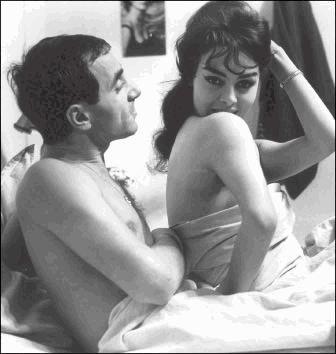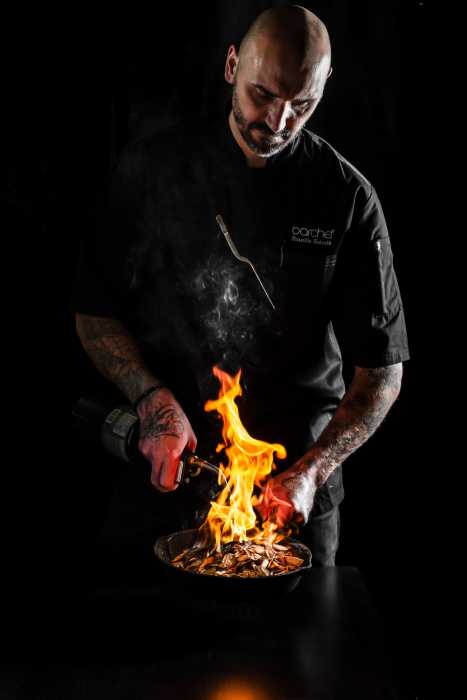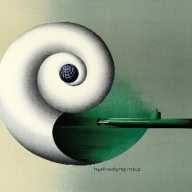By JERRY TALLMER
The patchwork quilt of ‘Shoot the Piano Player’
In “Breathless” (“A bout de soufflé”), made by 30-year-old Jean-Luc Godard in 1960, there is a fleeting moment when Jean-Paul Belmondo, as a magnetic Parisian nogoodnik named Michel Poccard, stands in front of a poster of Humphrey Bogart and worshipfully murmurs: “Buggee,” his approximation of Bogey.
I would have said “Breathless,” the movie that changed all movies from there on out, which is true enough, if it weren’t that in that same year of 1960, an even more structurally “different” movie – “Tirez sur le pianiste” (“Shoot the Piano Player”) – was being written and directed by Godard’s younger colleague Francois Truffaut, who had also written the story from which Godard derived “Breathless.
Indeed, “Shoot the Piano Player,” adapted by Truffaut from “Down There,” a novel by David Goodis (crossed with every two-bit Hollywood gangland potboiler Truffaut had ever devoured) seemed at the time to have no structure at all beyond a series of “takes” in the passive-aggressive guilt-ridden life of one man, that honkytonk piano player, whose name may be Charlie Kohler or, in an earlier, more successful incarnation, Edouard Saroyan.
At an estimate, throughout perhaps 75 percent of “Shoot the Piano Player” (you can check this when it opens here in a new 35mm print for a week at Film Forum, September 5-11), its withdrawn, self-sealed, fatalistic hero, or anti-hero, played (fabulously) by then 36-year-old Charles Aznavour, is encased in a trench coat with the collar protectively turned up, a la Bogart.
Or as Pauline Kael put it in her against-the-tide heralding of “Shoot the Piano Player” when in 1962 it reached these shores, both films – Truffaut’s “Piano Player” and Godard’s “Breathless” – “seem to be haunted by the shade of Bogart.” In short, by the stoic American tough guy – detective, cop, crook, reporter, con man – who walks alone, with his collar turned up, having been burnt (emotionally and otherwise) once or twice or five times too often. Or, more to the point, has savaged himself by hurting others. The kind of guy who will coolly consign to the electric chair the gorgeous woman who has bedded him but, as it happens, has also murdered his (however detestable) partner.
But that’s in another movie entirely, an American classic, “The Maltese Falcon,” the kind of Hollywood crime flick – if a lot more B’s and C’s and D’s than A’s like the “Falcon” – on which both Godard and Truffaut had gorged themselves as iconoclastic young critics for Les Cahiers de Cinema.
So it needn’t have been just Bogart, though Bogart was the prototype.
In any event, after Truffaut, not yet out of his 20s, had in 1959 crashed through to…well…immortality, with “The 400 Blows” (“Les quatre cents coups”), the story of his own storm-tossed boyhood, he deliberately set out to make a film – “Piano Player” – to get away from autobiography and from being “so French.”
Maybe so, but he would also say in 1980 that with “Piano Player” he “wanted to show three portraits of women who can pass through a man’s life,” and he does so here with actresses Nicole Berger, Michele Mercier, and most especially the delicious, strong-willed, flirty, loyal Marie Dubois, a Bacall-smile lookalike who will reappear in a bit part in “Jules and Jim,” the Truffaut masterpiece that will follow “Piano Player” within two years.
Macho man Norman Mailer once said that, with all the ladies in his life, things always began by the woman coming on strong to timid Norman. That is equally the case with reticent Charlie Kohler, and much thanks the women ultimately get for it. They die before his eyes, and ours, by murder, by suicide, by bullets in the snow (a scene later matched for heartbreaking shock at the end of John G. Avildsen’s 1970 “Joe.”
And Charlie Kohler/Edouard Saroyan? He does nothing about it. “Ger on your knees – or get away,” he advises himself in interior monologue when his waitress wife tells him she feels “like a woman split in two – heart here, body there” – after having slept with the sleazy impresario who might advance concert pianist Edouard Saroyan’s career. Charlie/Edouard cogitates, then turns and runs; he gets away. Quick cut to the wife’s body on the sidewalk. End of Edouard Saroyan’s concert career.
And yet this is also, first to last, a very funny movie – or funny movie mixed with not funny at all. Another snatch of interior monologue, as Charlie is following a beauty upstairs to her bedroom: “Don’t watch her legs or you’ll fall.” Appraising yet another beauty’s come-on-strong: “She’s interested. Who knows? Don’t mess this up.” And when, in her bedroom, the breasts pop out and the lights go out: “This is how they do it in the movies.”
The interior discourse is Charlie’s, but it is actually spoken by an actor other than Aznavour. Truffaut, who loved Aznavour and also loved and borrowed the name of the writer William Saroyan – two superb artists of Armenian blood – thought Aznavour’s voice was “too soft” for the monologue.
The links to plot, such as it is, or isn’t, lie in “the four abominable Saroyan brothers,” one of whom is Momo (Claude Mansard), a bumbling petty gangster on the run; one of whom is Fido (Richard Kanayan), a bright 10-year-old who pours obscuring milk on the bad guys’ windshield; one of whom is Richard (Jean-Jacques Aslanian), the eldest and least visible of the brothers; and one of whom is Edouard Saroyan or Charlie Kohler, as the case may be.
Or Francois Truffaut, as the case may be when it comes to women – more exactly, to showing “three portraits of women who can pass through a man’s life.” Truffaut, like all great directors, and most particularly like his compeer far to the north, Ingmar Bergman, or for that matter like Charlie Chaplin, connected more than cinematically with one after another of his stunning actresses.
The irony is that, two short years after “Shoot the Piano Player,” the Truffaut of “Jules and Jim” would be working with – falling in love with – Jeanne Moreau, the one woman who, in that film, as in reality, was not just three but all womankind wrapped into one.
“Shoot the Piano Player” begins with a scene that completely threw the reviewers (but not Ms. Kael, an admirer of Truffaut’s “anarchic nihilism”) off the track 47 or 48 years ago:
A gangster running away from gangsters (we later learn he is Momo Saroyan) bangs into a telephone pole, and is helped to his feet – is in fact rescued – by a total stranger who proceeds, as they walk from the scene, to gab away about his, the rescuer’s, married life. The gabber then walks clean out of the movie forever, and we, the audience, are left to make our own way into this extraordinary patchwork-quilt motion picture.
And as far as gabbing goes, one of those pursuing gangsters will later briefly reappear at the wheel of a kidnap car, prattling away to kidnapped Fido (the 10-year-old) in the back seat about all the marvelous gadgets and bargains that he (the gangster) has stashed away back at home. Speak of weird.
But is it patchwork, all this? Don’t worry. The strength of Truffaut’s anarchism and Aznavour’s reticence makes that question irrelevant.
SHOOT THE PIANO PLAYER. 1960. Directed by Francois Truffaut. Adapted by Truffaut and Marcel Moussy from “Down There,” a novel by David Goodis. 81 minutes. In French, English subtitles. September 5-11 at Film Forum, 209 West Houston Street, (212) 727-8110, filmforum.org.





































